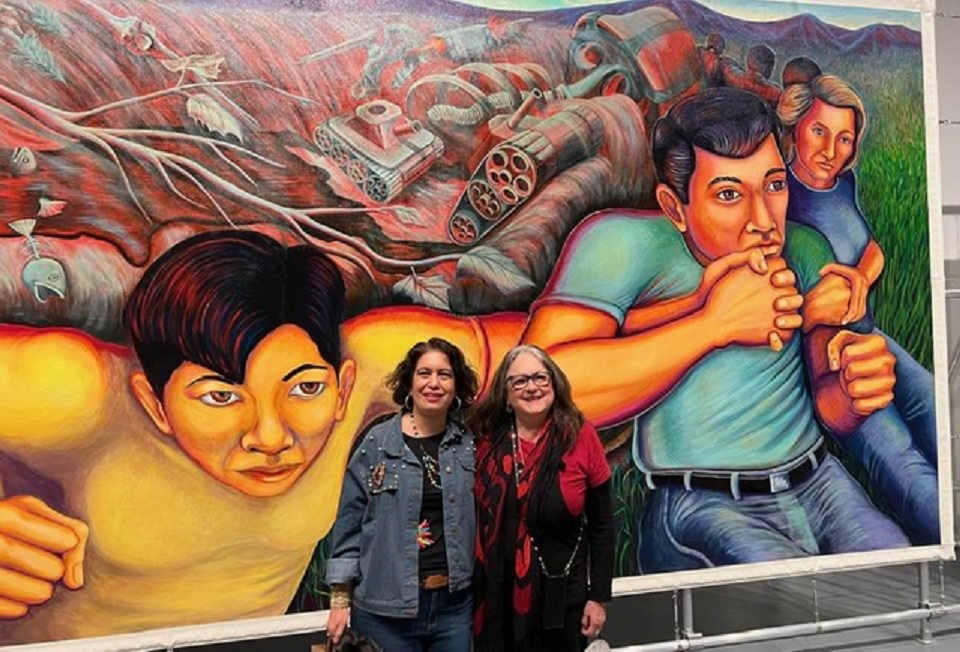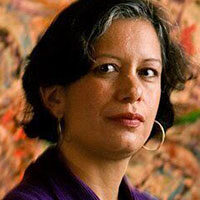
WASHINGTON, D.C. — President Joseph R. Biden presented the 2021 National Medals of Arts in conjunction with the National Humanities Medals on Tuesday, March 21, 2023, in a late afternoon live-streamed ceremony in the East Room of the White House. Among the recipients was radical Los Angeles-based artist and muralist Judy Baca.
National Endowment for the Arts (NEA) Chair Maria Rosario Jackson, Ph.D., said, “The National Medal of Arts recipients have helped to define and enrich our nation’s cultural legacy through their lifelong passionate commitment. We are a better nation because of their contributions. Their work helps us see the world in different ways. It inspires us to reach our full potential and recognize our common humanity. I join the President in congratulating and thanking them.”
The brief description of Baca’s work reads: “Judith Francisca Baca’s collaborative work has turned forgotten histories into public memory—pioneering an art form that empowers communities to reclaim public space with dignity and pride.”

The full list of medalists can be seen here.
I congratulate Judy Baca on receiving the National Medal of Arts!
I’ve known Judy since I was 21 when I worked as her painting assistant for the World Wall. She taught me so much! I brought her work to San Diego Mesa College years ago, where I teach, and I was honored when she asked me to curate her retrospective at the Museum of Latin American Art in Long Beach.
The following is an updated text that I wrote about her work. It was my script for a short video about her exhibition Memorias de Nuestra Tierra [Memories of Our Earth]. My late husband Mike [Davis] always told me that I am a good writer. And reading this I think, Yes!
Judy Baca is a Chicana artist and a pioneer in muralism as community art. She engaged in social practice before that term became popular. As a Chicana whose family crossed the Río Grande during the Mexican Revolution, Judy Baca understands the imperative to create sites of public memory. She knows that history has to be rewritten by everyone, not just those in power, not just by the victors or the colonizers. Judy Baca provides the visual vehicle to give voice to the forgotten, and the underrepresented.
The Neighborhood Pride program she spearheaded in Los Angeles through her organization Social and Public Art Resource Center (SPARC) installed scores of community-appropriate murals on walls in every ethnic neighborhood of the city, always employing local youth as assistants and volunteers.
This process began in the mid-1970s when she engineered a colossal project, a painting on the wall of the concreted Los Angeles River that would present California history from prehistoric times to the 1950s. The Great Wall of Los Angeles was painted by crews of young people: 400 high school students who not only filled in the colors, they also proudly included their own family histories. Judy brought together artists, historians, and, most important, people to bear witness: Zoot suiters, interned Japanese Americans, WWII Chicano veterans, Rosie the Riveters, Holocaust survivors, and Civil Rights activists. The mural emerged over a period of five summers and it stands as her greatest accomplishment and a model of engaged public art.

Judy Baca learned from Mexican muralist David Alfaro Siqueiros that art is a radical tool and that technology is the artist’s friend. Following the Great Wall project, where she captures the diverse and important history of Indigenous, Black, Brown, Asian, and Jewish Americans, Judy imagined how muralism could unite the world. Envisioned at the tail end of the Cold War, during Reagan’s presidency and under the shadow of possible nuclear war, Judy Baca hoped the world could swap missiles for murals. Following the lessons of Gandhi and the power of peaceful resistance, and building on the foundations of a nascent environmentalism, she created the project World Wall: A Vision of the Future without Fear. Freed from the wall, a series of portable canvases would travel across the globe. Murals were made by artists from Finland, the then Soviet Union, Mexico, Canada, and even an Israeli-Palestinian collaboration. Exhibited in each country, and laid out in a circle, the World Wall was an invocation for international solidarity and unity.
Accompanying these two ambitious projects are dozens more murals and monuments, sites of remembrance and celebration of the Indigenous, the Mestizo, the Chicano, and the Central American. The immigrant, the campesino, and the worker are the protagonists in a land that reveals simultaneously a painful past and a hopeful future. Judy weaves using brushes and pigment, but also layers with a stylus and pixels. She appropriates the kitschy “Sleeping Mexican” figurine and turns it into a testimony to sacrifice, labor, and hard work. A rascuache vendor cart—poor, coarse—is festooned with vignettes of braceros and migrants, essential workers who sustain our economy.
In surveying Judy Baca’s prolific artistic production, female characters stand as signposts, whether it’s her grandmother Josefina, a guardian sharing knowledge of herbs and healing, or inciting Judy to make art that connects with others and has meaning. Or, whether it’s the rebelde tía—the rebel aunt—that inspired the Pachuca series, gesturing with fiercely lined eyes and a crooked pout. Women in her work appear as warriors, corn goddesses, marathon runners, domestic workers, and hijas, daughters of Juárez. And amongst these, her matriarchal mural stands out as a significant ode to women of color, young and old. In this beautiful two-sided mural, Judy Baca captures the undeniable power of the female spirit.
Eric A. Gordon contributed to this article.
We hope you appreciated this article. Before you go, please support great working-class and pro-people journalism by donating to People’s World.
We are not neutral. Our mission is to be a voice for truth, democracy, the environment, and socialism. We believe in people before profits. So, we take sides. Yours!
We are part of the pro-democracy media contesting the vast right-wing media propaganda ecosystem brainwashing tens of millions and putting democracy at risk.
Our journalism is free of corporate influence and paywalls because we are totally reader supported. At People’s World, we believe news and information should be free and accessible to all.
But we need your help. It takes money—a lot of it—to produce and cover unique stories you see in our pages. Only you, our readers and supporters, make this possible. If you enjoy reading People’s World and the stories we bring you, support our work by donating or becoming a monthly sustainer today.












Comments